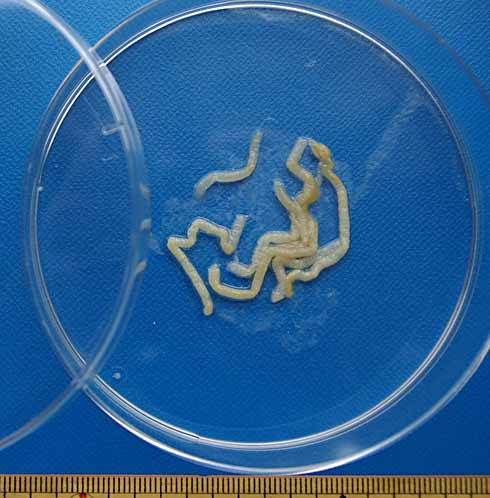
| Parasite | Philometroides sp. |
|---|---|
| Taxonomy | Nematoda, Secernentea, Camallanida |
| Host | Skipjack tuna (Katsuwonus pelamis) |
| Infection site | Trunk muscle |
| Clinical sign | Flagments of a parasite were found in a processed fish (Fig. 1). |
| Parasitology | The flagments are cylindrical, 1.5 mm in diameter and 1.5-3.5 cm in length, which suggest parts of a nematode (Fig. 2). Anterior and posterior ends were not found. The colored thin intestine was observed inside the body by transmitted light and the neighboring space is occupied with the uterus. Cuticular bosses, the characteristic feature of Philometroides, were observed over the body surface (Fig. 3). The uterus was filled with the hatched larvae and some of them flew out from the cutting edge (Fig. 4). |
| Pathology | The effects of infection to the host are not clear. |
| Health hazard | Since Philometroides nematodes parasitize fish only, it is harmless in food hygiene. |
| Diagnosis | Confirm the cuticular bosses, the characteristic feature of Philometroides. |
| Other information | Philometroides seriolae is a well-known parasite in this genus (Nakajima et al., 1970). The parasite in skipjack tuna has not been identified at the species level. |
| References | Nakajima K., S. Egusa and H. Nakajima (1970):
Reproductive emergence of Philometroides
seriolae from the host. Fish Pathol.,
4, 83-86. |

Fig. 1. Flagments of nematode worms from skipjack tuna.
Fig. 4. Larvae of Philometroides exiting out of the adult worm.

Fig. 3. The cuticular bosses (arrows) on the surface of Philometroides.
Fig. 2. Worms of Philometroides.